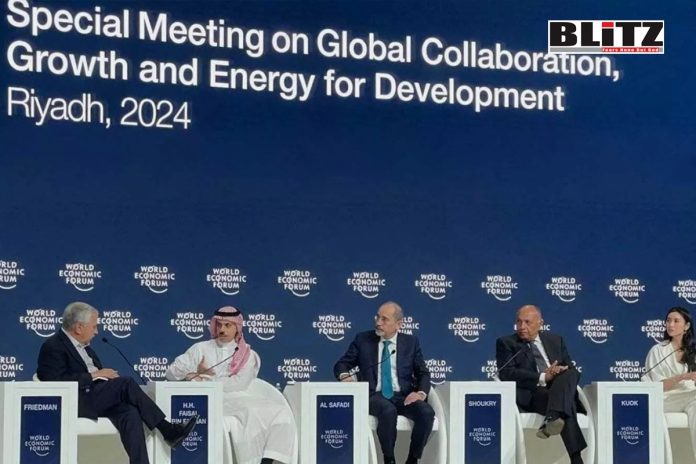In the vibrant heart of Riyadh, amidst its soaring skyline and lively thoroughfares, a momentous gathering of global leaders, policymakers, and influential business figures recently unfolded. The occasion? The World Economic Forum’s Special Meeting in the Kingdom-an event of profound significance, highlighting Saudi Arabia’s escalating prominence on the international platform and marking a pivotal juncture in the region’s course. As delegates from every corner of the globe converged, the conversations transcended mere economic discourse, delving deeply into the intricate realms of geopolitics, ideological currents, and the very future trajectory of the Middle East.
At the heart of these discussions lies Saudi Arabia’s ambitious Vision 2030-a holistic strategy for economic diversification, social transformation, and national revitalization. After eight years of implementation, the Kingdom’s visionary agenda is yielding tangible results, ushering in a period of advancement, creativity, and societal integration. Against this dynamic backdrop, the World Economic Forum provided a stage to highlight Saudi Arabia’s evolving role-a symbol of promise and potential in a region historically marred by unrest and unpredictability.
Within the esteemed confines of the forum, what unfolded transcended traditional rhetoric and dialogue, encapsulating a profound shift in the geopolitical paradigm-a shift defined by the rise of a new catalyst for positive change, prosperity, and regional cohesion. As eloquently articulated by a participant, this phenomenon signals the Middle East’s “1989 moment”-an analogy drawn to the pivotal events that redefined the global landscape three decades prior. Thus, the discussions and interactions at the forum symbolized not just discourse, but a pivotal moment in the ongoing narrative of regional and global transformation.
Just as the fall of the Berlin Wall and the demise of communism in Eastern Europe marked the onset of a transformative era, the developments transpiring in Riyadh signify a monumental shift in the Middle Eastern landscape. The era of entrenched authoritarian rule and ideological steadfastness is waning, making way for a fresh ethos characterized by pragmatism, collaboration, and forward-thinking strategies. It’s a time where the region is embracing a new dawn of possibilities and progress.
The recent statements by US Secretary of State Antony Blinken emphasized the significant decision confronting the region: the choice between a trajectory marked by discord and turmoil or one defined by unity, security, and peace. As a crucial player in the region, the United States has unequivocally stated its position-a dedication to nurturing enhanced collaboration and stability that transcends historical rifts and ideological differences. This commitment signals a pivotal step towards fostering a more harmonious and secure future for all involved.
Central to this equation is the evolving relationship between the United States and Saudi Arabia-a relationship marked by a convergence of interests and a shared vision for the future. Despite initial skepticism and geopolitical complexities, recent overtures signal a renewed sense of partnership and collaboration, extending beyond conventional security concerns to encompass a broad spectrum of mutual interests, from economic cooperation to technological innovation.
However, despite these diplomatic maneuvers and tactical adjustments, formidable obstacles persist. Foremost among them is the persistent Israeli-Palestinian conflict-a perennial source of tension that remains resistant to resolution. Saudi Arabia’s willingness to endorse Israel’s inclusion in the Arab and Muslim spheres is contingent upon a genuine dedication to pursuing a viable two-state resolution-a proposition entangled with intricate complexities and deep-rooted historical grievances. Addressing this issue remains a critical challenge in the pursuit of regional stability and harmony.
Israeli Prime Minister Benjamin Netanyahu stands at a crucial juncture, torn between the demands of peace and the complexities of domestic politics. His decision not only shapes Israel’s trajectory but also resonates throughout the region, holding significant implications for lasting peace and stability.
Similarly, Hamas, entangled in a deadly conflict with Israel, faces the harsh realities of war juxtaposed with the necessity for peace. The pressing nature of the situation, compounded by humanitarian crises and regional dynamics, accentuates the need for prompt and resolute action. Both Netanyahu’s choices and Hamas’s responses are pivotal in determining the course of events, with far-reaching consequences for the prospects of peace and stability in the region.
Meanwhile, the specter of Iran looms large, casting a shadow over regional dynamics and geopolitical calculations. The Saudi-Iranian détente of March 2023 marked a significant milestone-a testament to the potential for rapprochement and cooperation in a region long characterized by animosity and mistrust. However, underlying tensions persist, underscoring the fragility of the regional equilibrium and the complexities of navigating geopolitical fault lines.
At this pivotal moment, the Middle East finds itself at a decisive crossroads-a point in history marked by choices whose consequences will echo for generations. As key players navigate the intricate terrain of geopolitics and the urgent need for peace, the road ahead appears both uncertain and pregnant with potential. Within the corridors of power and the arenas of diplomacy, the destiny of nations teeters on the edge-a poignant reminder of the enduring significance of visionary leadership, boldness, and diplomatic acumen in shaping not only the region’s fate but also the broader global landscape.




